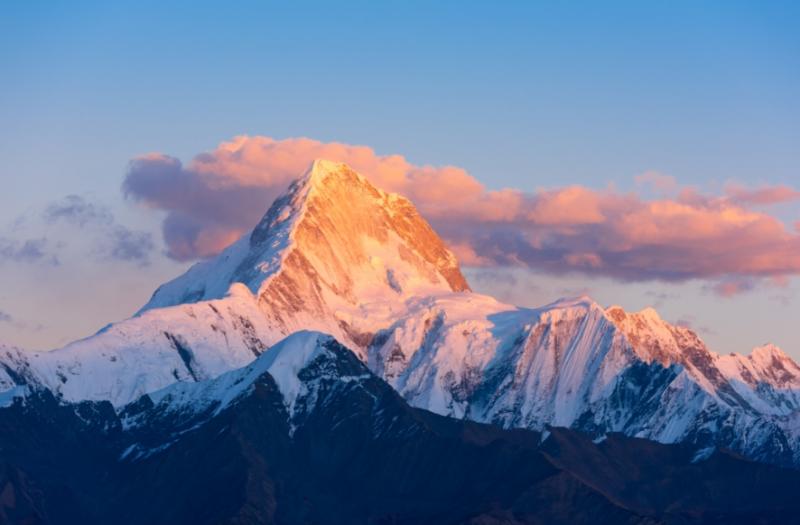Mount Gongga

I. The Imposing Summit of the East
1. Location and Elevation: Mount Gongga is located in western Sichuan Province, the main peak of the Daxue Mountains in the middle section of the Hengduan Mountains. It stands at 7,556 meters above sea level, making it the highest peak in mainland China and one of the world's renowned "Seven Great Peaks".
- Specific Location: It is situated at the junction of Kangding, Liding, and Shimian counties, belonging to the Hengduan Mountains on the eastern edge of the Qinghai-Tibet Plateau.
- Elevation: Reaching 7,556 meters, it towers above surrounding peaks. Its summit is perpetually covered in snow, shrouded in mist, resembling a silver giant.
2. Magnificent Natural Scenery: Mount Gongga is renowned for its majestic posture and magnificent natural landscapes.
- Glaciers and Snow Peaks: Mount Gongga boasts glaciers and snow peaks of rare beauty in the world, covering an area of over 200 square kilometers. Glaciers wind like jade ribbons, while snow peaks are pristine white like snow princesses.
- Forests and Meadows: The slopes are covered in dense forests and vast meadows, boasting rich and diverse vegetation. This is a haven for rare animals and plants.
- Rivers and Lakes: Mount Gongga nourishes numerous rivers and lakes, such as the Gongga River and Haizi Gou, providing essential water sources for the surrounding ecosystem.
II. Rich Cultural Connotations
1. Religion and Legends: Mount Gongga is revered as a sacred mountain in local Tibetan culture and has close ties to Buddhism.
- Sacred Mountain Belief: The Tibetan people view Mount Gongga as an embodiment of the divine, worshipping it and building numerous temples and stupas as places for pilgrimage and practice.
- Mythical Legends: Legends and stories about Mount Gongga have been passed down through generations, such as the legend of the "Gongga Goddess," and stories about guardians and mountain deities.
2. Ethnic Culture and Customs: Around Mount Gongga live diverse ethnic groups including Tibetans, Yi people, and Han Chinese, each with unique cultures and customs.
- Tibetan Culture: The Tibetan people's religious beliefs, traditional clothing, folk songs and dances, and dietary habits are closely linked to Mount Gongga.
- Yi Culture: The Yi people's sacrificial rituals, dance performances, handicrafts, etc., also reflect their reverence for mountain deities and their awe of nature.
3. Historical and Cultural Heritage: The area surrounding Mount Gongga boasts rich historical and cultural heritage, including ancient paths, temples, and stone carvings.
- Ancient Path Sites: Mount Gongga's vicinity was once a vital route on the ancient Tea Horse Road, leaving behind numerous ancient path sites, witnessing the changing tides of history.
- Temple Architecture: Numerous ancient temples are scattered around Mount Gongga, such as the Jiagu Temple in Danba Jiagu Tibetan Village, and the Mengding Temple on Mengding Mountain in Ya'an, serving as significant cultural centers of Tibetan Buddhism.
III. Challenges and Protection
1. Climbing Challenges: Mount Gongga is known for its treacherous terrain and harsh weather conditions, attracting mountaineers from around the world as a world-class alpine climbing destination.
- Technical Difficulty: The mountain's steep slopes, glacier development, frequent avalanches and landslides make climbing extremely challenging.
- Climate Change: The climate on Mount Gongga is unpredictable, often experiencing blizzards, hailstorms, and thunderstorms, posing enormous challenges to climbers.
2. Ecological Environment Protection: Mount Gongga's ecological environment is fragile and has faced certain challenges due to human activities in recent years.
- Tourism Development: With the rise of tourism, visitor numbers have been increasing, putting pressure on the ecological environment.
- Environmental Pollution: Waste disposal, water pollution, and other issues have had a certain impact on the ecological environment of Mount Gongga.
3. Sustainable Development: Balancing tourism development with the protection of Mount Gongga's ecological environment is a significant challenge.
- Establishing Nature Reserves: A national nature reserve has been established in the Mount Gongga region to protect the ecosystem within the area.
- Strengthening Ecological Monitoring: Monitoring the ecological environment of Mount Gongga allows for timely problem identification and the adoption of effective measures for remediation.
- Promoting Eco-tourism: Encouraging eco-tourism and guiding tourists to practice responsible tourism minimizes environmental impact.
Conclusion: Mount Gongga, a majestic peak, a sacred site of culture, and a symbol of challenge and protection. We should cherish this invaluable natural heritage and protect this pearl of the "Eastern Summit" with concrete actions.